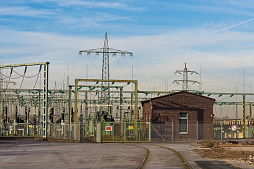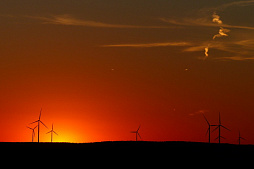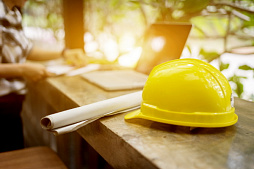Onshore wind farm: financing, engineering and equipment supply
GCAM Investment Group offers:
• Investment financing from €50 million and more
• Minimizing the contribution of the project promoter
• Investment loan term up to 20 years
• Loan guarantees
The multibillion-dollar investment has made it possible to rapidly reduce the cost of wind turbines and build new facilities around the world.
In 2020, WindEurope published a report based on the National Energy and Climate Plans submitted by EU member states.
If all countries meet their commitments, the capacity of offshore and onshore wind farms in Europe will increase to almost 400 GW by 2030.
Europe currently has about 197 GW of installed wind capacity, of which 174 GW is for onshore wind and 23 GW for offshore projects.
This represents about 30% of the world's land-based wind energy potential. In 2019, European wind farms generated about 417 TWh of electricity, corresponding to 15% of total demand.
The use of wind energy is beneficial only in areas with constant and relatively strong winds.
Offshore wind turbines are usually larger, although the technology base is similar to onshore wind turbines. Experts are confident that offshore wind farms have better prospects, as the use of more powerful winds on the high seas provides twice the electricity production compared to similar facilities installed on the shore.
Although offshore projects are actively developing today, preserving valuable agricultural and forest areas, the construction of onshore wind farms is the most affordable energy solution for business and society. The fact is that offshore wind turbines are more expensive to manufacture and build, and laying cables under water is more difficult.
About 90% of the installed wind capacity today comes from onshore facilities, while offshore wind power has a long way to go to commercial success.
If you are interested in financing and construction onshore wind farms, please contact GCAM.
Construction of onshore wind farms
The life cycle of a wind farm includes planning, engineering design, construction, operation, expansion, modernization and closure.Each of these stages requires professional involvement and the use of the most advanced technologies in order for the project to meet your expectations.
GCAM's team is ready to assist your company in the implementation of any wind power project. Together with partners, we cooperate with leading scientific institutions, equipment manufacturers and contractors, offering optimal solutions to each client.
We also offer cheap sources of funds to finance the construction of onshore wind farms through international investment funds.
Wind farm planning
Today, the construction of an onshore wind farm takes an average of 5 to 8 years, depending on the site chosen, installed capacity and many other factors.Conducting comprehensive research
A new wind energy project starts with careful planning and evaluation of the selected site.Experts conduct detailed studies, assess orographic conditions, wind strength and direction, seismic activity and other aspects.
Buying land and obtaining permits
Much attention is paid to forecasting the environmental and socio-economic consequences of future construction.Research results will be required to obtain permits and negotiate with the authorities.
The official building permit requires the approval of various aspects of the project with the authorities responsible for the environment and protection of natural resources, health of local residents, traffic, generation and distribution of electricity.
Electricity supply agreement
The preparation and signing of agreements on the supply of electricity and connection to the national power grid is one of the most difficult and crucial stages.This task includes multi-stage negotiations and the execution of expensive work on a tight schedule.
Thanks to the experience in the implementation of energy projects in different regions of the world, our partners are ready to deal with negotiations and obtaining permits. Experienced lawyers with international experience guarantee the success of a new project with minimal involvement of your staff.
Manufacture of wind turbines and other components
Some components, such as transformers and wind turbines, take a long time to manufacture (up to 6 months), so it is important to start the process as soon as possible.Tenders and negotiations are held with leading companies, and equipment tests are carried out under the supervision of specialists.
GCAM and its partners cooperate with leading wind farm equipment manufacturers to ensure the production of high quality components on favorable terms and conditions in a very short time frame. Contact us to learn more about partners.
Onshore wind farm construction stages
The construction of an onshore wind farm typically involves five stages:• Construction of access roads for equipment transportation.
• Preparation of construction site and storage facilities for building materials.
• Construction of foundations for wind turbines and auxiliary buildings.
• Cable laying and other electrical work on the site.
• Assembly and installation of wind turbines.

A prerequisite for the successful implementation of a wind energy project is the conduct of comprehensive research, planning and coordination of the construction of wind power plants with local authorities.
The GCAM team will assist you at every stage of the project.
Access road construction
Transporting a wind turbine overland is fraught with many technical difficulties that require professional engineering solutions and the widespread use of advanced technology, including heavy cranes.The construction of an onshore wind farm requires the preparation of wide access roads with specific requirements due to the size of the components to be moved and the weight of the semi-trailers used to transport them.
Although modern road construction technologies minimize the use of land at this stage, permits from the local government must be obtained in advance, providing a detailed plan of activities and a scheme of access roads.
When constructing access roads, the engineering team must consider such important parameters as the minimum radius of curvature, the maximum slope of the road, or the width of the road in certain areas.
It should also be borne in mind that individual components of the tower reach 40-50 meters in length and weigh tens of tons.
The stages of building access roads include the following:
• Planning of work areas.
• Obtaining construction permits.
• Restriction of traffic in the construction area.
• Provision of construction crews with equipment and housing.
• Removal of vegetation and leveling of soil for construction.
• Laying the road surface from durable materials.
• Dismantling of temporary structures.
Some roads will be temporary and their use is limited to the initial phase of construction.
Others should be permanent roads for maintenance and control over the life of the wind farm.
Preparation of the construction site and storage areas
When it comes to transporting equipment, the installation of wind turbines requires an extensive support infrastructure.This includes the erection platforms on which the cranes are operated to lift parts of the tower and nacelle.
It should be borne in mind that a fortified platform for a heavy crane should have an area of at least 350-400 square meters. In addition, nearby should be equipped with places for storing wind turbine components, building materials and equipment.
The use of heavy machinery and numerous small vehicles requires the arrangement of appropriate parking areas, fuel and lubricant storage areas, and repair shops.
It is also important to provide sources of technical and drinking water.
Construction of foundations and auxiliary buildings
A modern onshore wind farm is a complex system linked by a control center.It is connected to the general power system through an electrical substation.
A wind farm control center is dependent on equipment specifications and requires a significant amount of construction work. Warehouses, utility rooms and much more are also provided.
Building foundations for wind turbines can be called one of the most expensive and time-consuming steps in the entire project. Given the size and weight of onshore wind turbines, these foundations require thousands of tons of concrete and steel.
The foundations must meet a number of stringent technical requirements for frost resistance, water resistance, mechanical strength, tower joining technologies, and so on. The quality of the foundation is the key to a long and trouble-free operation of the wind generator with minimal maintenance and repair.
Cable laying and substation construction
Unlike other forms of energy, electrical energy cannot be stored in large quantities.Electricity requiring constant consumption must be produced simultaneously with consumption. This requires special equipment to balance production and consumption.
The electrical system of an onshore wind farm is designed to efficiently transfer the energy produced by each wind turbine directly to the grid of an electrical company that supplies nearby cities or industrial consumers.
There are underground medium voltage lines that connect several wind turbines together with a substation, which is usually laid along the access roads, reducing the negative impact on the environment. These medium voltage cables are connected to a high voltage electrical substation.
Electrical work during the construction of onshore wind farms includes:
• Earthwork, including blasting.
• Supply of electrical equipment and construction of a substation.
• Laying of underground cables between the substation and wind turbines.
• Connection of the transformer substation to the power grid.
• Reinforcing equipment to increase reliability in extreme conditions.
The characteristics of the equipment and the distance to the connection point will determine the design and location of each wind farm's electrical substation and the engineering design of the power transmission lines.

Assembly and installation of wind turbines
After the delivery of the tower, nacelle and rotor components to the construction site, specialists assemble the equipment and install the finished wind turbines on the pre-built foundations.Usually this operation is carried out using two cranes.
The main principles of our work are reliability and customer-oriented service.
Contact us to find out more.
Onshore wind farms: frequently asked questions
In this section, we will answer some of the frequently asked questions from investors regarding the construction and operation of onshore wind farms.It should be understood that the answers to some of these questions depend on the technology chosen and the host country regulations in force.
If you are interested in financing or wind energy, you can contact GCAM specialists for advice at any time.
How does a wind turbine work in the absence of wind?
When there is no wind or the wind speed is below the minimum value for generating electricity, the onshore wind farm can consume the energy from the external grid, which is necessary to keep the devices running.The rotation of the wind turbine rotor occurs exclusively due to the wind energy applied to the rotor blades. Accordingly, when the wind stops completely, the rotor stops. For this reason, a detailed preliminary study of the wind resources of a particular location is critical to the success of the project.
Do wind generators have emergency shutdown equipment for significant changes in wind speed, lightning strikes, or power grid problems?
A modern wind farm is necessarily equipped with controllers that check all operating parameters in real time.When the key indicators of the power grid exceed the levels set by the controller, the wind farm will shut down according to the protection algorithm.
The number of lightning strikes at onshore wind farms can reach several hundred per year, and this is completely normal. Modern wind turbines are equipped with highly efficient lightning protection systems. The system can take lightning strikes without damaging or stopping the wind farm.
Also, wind turbines have special protective devices that block the rotation of the rotor when the wind speed is significantly exceeded.
Thanks to the use of durable materials in combination with smart electronics, wind farms are now adequately protected from natural disasters and emergencies in the power grid.
Wind farms are designed in such a way that even hurricane winds do not damage the structure. However, rotating elements such as the rotor hub and blades attached to it are particularly vulnerable to damage.
To eliminate the risk of failure of these elements, maintenance procedures include periodic inspection of the tightening of threaded connections.
How does wind turbine noise affect people and animals?
There is currently no scientific evidence that wind farms are harmful to human health.The claims of some opponents of onshore wind farms about the increased incidence of disease in local communities are unfounded.
The sound of the rotation of the rotor blades in a light wind can be compared to the rustle of branches. This is considered insignificant for human health, since the rotational speed of the blades is about 1 Hz, and the human ear is not sensitive to this frequency.
In addition, modern blade designs reduce noise emissions through the use of variable blade pitch and a specially shaped trailing edge.
Do wind farms affect birds and bats?
Wind farms can actually hurt birds and bats.They can become an obstacle to flocks of birds, forcing them to look for alternative routes during migration.
Birds can also avoid living near running turbines. Building an onshore wind farm could force some birds to abandon their habitats or lead to the loss of shelter and feeding places for bats.
The most obvious environmental impact of wind farms is bird deaths as a result of collisions with rotating blades. This risk depends on the size of the wind turbines and the location of the wind farm.
Comprehensive environmental studies at the planning stage of an investment project minimize the threat. After the completion of the research process and consultation with authorities, a permit is issued, which determines the conditions for the construction and operation of the wind farm.

Are wind farms dangerous for aircraft?
The considerable height of wind generators makes them a dangerous obstacle to air traffic.This fact must be taken into account in engineering design and obtaining permits. At the design stage of the wind farm, its location is coordinated with the departments of civil and military aviation.
As construction begins on the onshore wind farm, new obstacles are added to the aeronautical maps used by pilots. In addition, each wind turbine is equipped with lanterns, thanks to which it is visible in any meteorological conditions, both during the day and at night.
What are the stages of building an onshore wind farm?
After selecting a site, developing a project and analyzing wind resources, the proponents of the project need to buy or lease a plot of land for the future wind farm.Along with this, a number of studies and examinations will have to be carried out, the result of which is obtaining a permit for the construction of a wind farm in a specific location.
In some cases, local authorities may require the company to provide environmental reports and even archaeological research. These requirements vary significantly from country to country and from municipality to municipality.
What are the minimum distances from wind turbines to residential buildings?
The location of the wind farm is determined by local requirements.These standards may differ. In general, European standards require wind turbines to be built at least 10 times the height of the facility from residential buildings, measured from ground level to the highest point of the blade.
For example, when using modern high-power wind turbines, the total height of the facility can exceed 200 meters. Consequently, onshore wind farms can be built at a distance of about 2000 meters from residential buildings.
How much does a wind turbine weigh and how is it transported?
Typical wind turbines, together with tower elements, weigh about 300-400 tons, excluding the mass of the foundation.The blades, which are sometimes disassembled into several segments for ease of transportation, can weigh over 10 tons. Their assembled length is about 50 meters, which makes transporting an entire blade by road an incredibly difficult logistical task.
However, the main components of an onshore wind farm are transported by land and much less often by rivers. Most often, transportation is carried out by special semi-trailers. Each component is supplied individually.
Before the items leave the storage location, a special route is laid to their destination, which is expanded with temporary road plates. They also produce semi-trailers, thanks to which the blades can be transported at an angle of up to 40 degrees.
Our partners have extensive experience in implementing large wind energy projects in Europe, North Africa, Latin America and other regions of the world.
Specialists are ready to develop original technical solutions for any natural conditions in order to best meet the needs of your business.
Are you looking for funding to build an onshore wind farm?
Consult the GCAM Investment Group finance team to learn more about our services.




















